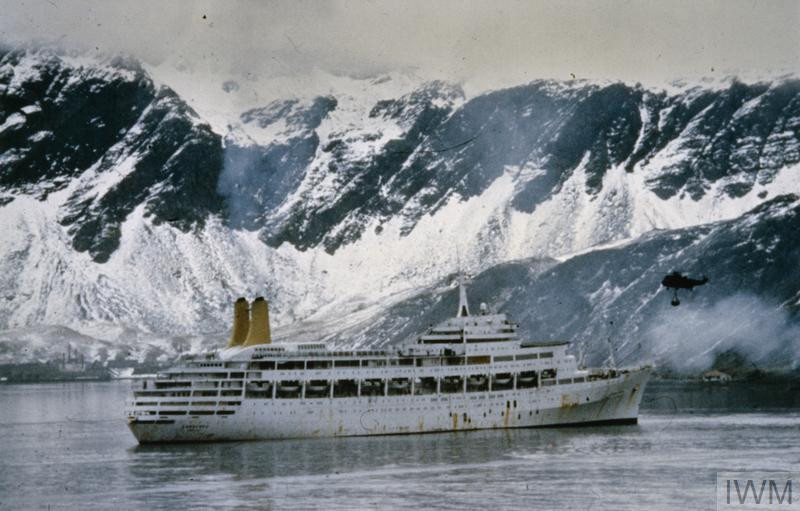Thursday 27 May 1982 saw some significant arrivals in the South Atlantic, one significant departure, and an Argentine air raid on the San Carlos landing area that resulted in the deaths of eight British Servicemen, seven of them Royal Marines.
One of the most notable arrivals was that of Queen Elizabeth 2, which reached Cumberland Bay East in South Georgia on 27 May with her complement of Gurkhas, Scots Guards and Welsh Guards – the 5th Infantry Brigade.
Before reaching South Georgia QE2 had stopped to allow General Jeremy Moore RM, who was to take over as commander of ground forces from Brig Julian Thompson RM, and Brigadier Tony Wilson, who commanded the 5th Infantry Brigade, to transfer to HMS Antrim.
The destroyer then sailed west, delivering the senior officers to HMS Fearless.
Having arrived in South Georgia, QE2 said farewell to her passengers, with the Guards moving to the other liner, Canberra (which had sailed to South Georgia from the Falklands with survivors from HMS Ardent), and the Gurkhas joining the North Sea ferry Norland (which had brought in survivors of HMS Antelope).
Departing from the South Atlantic was Type 42 destroyer HMS Glasgow, which had been patched up as much as possible by teams from repair ship Stena Seaspread in the TRALA (Tug, Repair and Logistics Area) before her long passage north back to the UK.
Since 25 May, the weather had pretty much prevented Argentine air activity, but on 27 May a bombing run on the San Carlos Water landing area saw men and materiel bombed and strafed by two pairs of Skyhawk jets.
One pair killed six men of 45 Cdo RM and Commando Logistic Regiment, wounded others and leave two unexploded bombs close to the field hospital at Ajax Bay.
The second pair of aircraft attacked San Carlos, killing one man each from 40 Cdo RM and 59 Ind Cdo Sqn RE; one of these Skyhawks was shot down over West Falkland by Bofors gunfire from one of the two assault ships, HMS Fearless or HMS Intrepid.
The men who died were:
Mne Colin Davison (Commando Logistic Regiment), Ajax Bay
Mne Paul David Callan (45 Cdo), Ajax Bay
Sgt Roger Enefer (45 Cdo), Ajax Bay
Cpl Kenneth Evans (45 Cdo) , Ajax Bay
L/Cpl Peter McKay (45 Cdo), Ajax Bay
Mne David Wilson (45 Cdo), Ajax Bay
Mne Stephen McAndrews (40 Cdo), San Carlos
Sapper Pradeep Gandhi (Royal Engineers, 59 Ind Cdo Sqn), San Carlos
During 27 May, progress was made in cutting out two of three access holes for the removal of the remaining unexploded bomb in frigate HMS Argonaut.
Repair work continued in Landing Ship Logistic RFA Sir Galahad, while members of Fleet Clearance Diving Team 3 continued to work on the unexploded bomb in RFA Sir Lancelot.
Elsewhere in the wider South Atlantic on 27 May tanker RFA Bayleaf sailed from Ascension Island, Leaf-class sister RFA Appleleaf carried out a replenishment at sea (RAS) with destroyer HMS Exeter in the Total Exclusion Zone around the Falklands, tanker RFA Olmeda RASed with aircraft carrier and task force flagship HMS Hermes, while RFA Tidespring launched her crash boat to provide medical help to a sailor in carrier HMS Invincible.
The RAF lost a ground attack Harrier GR3 on 27 May; the aircraft was hit by small arms fire during a bombing mission over Goose Green in preparation for an attack by 2 Parachute Regiment, and although the jet crashed its pilot ejected safely.
Today’s image from the Imperial War Museum collection (© IWM FKD 340) shows P&O liner Canberra at Grytviken, South Georgia, during the transfer of members of 5 Infantry Brigade from Queen Elizabeth 2 in late May 1982.
* These posts can only give a brief sense of what was a complex and fast-moving situation 40 years ago, and cannot cover the involvement of every ship, squadron and unit in detail – for a much more comprehensive account see the Falklands section of naval-history.net at https://www.naval-history.net/NAVAL1982FALKLANDS.htm
